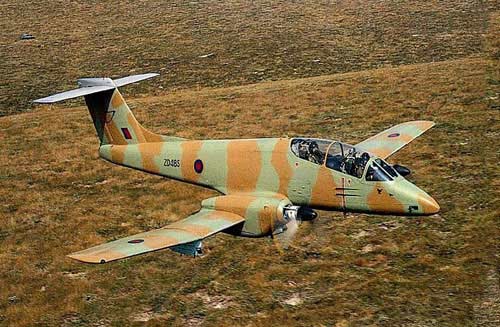IA 58 Pucará
Summary
| Category | Combat Aircraft |
| Origin country | 🇦🇷 Argentina |
| Manufacturer | FMA |
| First flight | 8 November 1974 |
| Year introduced | 1976 |
| Number produced | 110 units |
| Average unit price | $2 million |
Description
In August 1966, the Argentine state aircraft factory, Dirección Nacional de Fabricación e Investigación Aeronáutica (DINFIA), initiated the development of the AX-2, a Counter-insurgency (COIN) aircraft under the guidance of engineer Aníbal Dreidemie to meet the Argentine Air Force's requirements. To validate the proposed configuration, DINFIA constructed a full-scale unpowered glider test vehicle, which successfully completed its first flight on December 26, 1967. Following encouraging results from the glider tests, construction of a powered prototype began in September 1968, designated FMA IA 58 Delfín, later renamed Pucará. The initial engine choice was a pair of 674 kilowatts (904 hp) Garrett TPE331I/U-303 engines; however, the first prototype made its maiden flight on August 20, 1969, with a switch to 729 kW (978 shp) Turbomeca Astazou XVIGs for the second prototype, which flew on September 6, 1970. The Astazou engine was selected for the production version, leading to the creation of a third production prototype in 1973. The first production model then flew on November 8, 1974, with deliveries commencing in early 1976.
The IA 58 Pucará features a conventional, all-metal construction, primarily using duralumin. Its unswept cantilever wings have a 7-degree dihedral on the outer panels and are equipped with slotted trailing-edge flaps. The fuselage is slender, housing a tandem cockpit with Martin-Baker zero/zero ejection seats beneath an upward-opening clamshell canopy. Armour plating protects the crew and engines from ground fire. It is powered by two Turbomeca Astazou engines, which drive three-bladed Ratier-Forest propellers that can also function as air brakes. The aircraft is designed for operations from short, rough airstrips, featuring retractable tricycle landing gear with low-pressure tires and tall undercarriage legs for ample ground clearance. Fuel is supplied from two fuselage tanks with a combined capacity of 800 liters and two 460-liter self-sealing tanks in the wings. Hydraulics operate the undercarriage, flaps, and brakes.
The IA 58 Pucará features a fixed armament suite comprising two 20 mm Hispano 804 cannons mounted under the cockpit, each with 270 rounds, and four 7.62 mm Browning FN machine guns located on the sides of the fuselage, with 900 rounds each. Additionally, the aircraft is equipped with three hardpoints for carrying external stores either singly or in clusters. These include a centerline hardpoint with a capacity of 1,000 kg (2,200 lb) and two wing pylons capable of carrying 500 kg (1,100 lb) each, enabling a total external weapons load of up to 1,620 kg (3,570 lb). This allows for a variety of ordnance such as bombs, rockets, or external fuel tanks, as well as ARM-657 Mamboretá rocket pods. Aiming of the onboard armaments is achieved via a simple reflector sight.
The IA 58 Pucará saw its operational debut in May 1975 with the Argentine Air Force, equipping the 2° Escuadron de Exploración y Ataque and participating in counter-insurgency strikes against ERP guerillas in Tucumán Province as part of Operativo Independencia. During the Falklands War, approximately 60 Pucarás were in service, proving valuable due to their ability to operate from small airfields. Deployed to Port Stanley and smaller airstrips, they performed reconnaissance and light-attack roles, armed with bombs, rockets, and machine gun pods. Three Pucarás were destroyed at Goose Green by Sea Harriers, and six more were lost in the SAS Raid on Pebble Island. One Pucará was shot down by a Stinger SAM, while another fell to Sea Harrier cannon fire after a successful raid. Two Pucarás achieved a confirmed air-to-air victory by shooting down a Royal Marines Scout helicopter. Post-war, eleven Pucarás were captured by British forces. Later, the Sri Lanka Air Force acquired Pucarás for counter-insurgency operations, finding them effective for close air support. However, the type's limitations, including the lack of an oxygen system and countermeasures against SAMs, led to its eventual retirement in 1997, with Mil Mi-24 helicopter gunships taking over its role.
Main Variants:
-
IA-58A Pucará: The main production version, this two-seat aircraft was designed for counter-insurgency, close air support, and attack roles.
-
IA-58B Pucará Bravo: This modified two-seat version featured a deeper forward fuselage to accommodate two 30 mm DEFA cannons in place of the 20 mm Hispano cannon, along with more advanced avionics.
-
IA-58C Pucará Charlie: A single-seat variant developed after the Falklands War, it was intended to enhance anti-shipping and anti-helicopter capabilities with additional 30 mm DEFA cannons, Matra R550 Magic air-to-air missiles, and Martin Pescador air-to-surface missiles.
-
IA-58D Pucará Delta: This is a current modernization program upgrading existing IA-58A airframes with new avionics systems and more powerful PT6A-62 Pratt & Whitney engines.
-
IA-58 Pucará Fénix: This conversion, initiated in 2019, repurposes the Pucará from counterinsurgency to border surveillance and patrol aircraft with improved engines, new propellers, and an electro-optical/infrared sensor turret.
Technical specifications
| Version: IA 58 Pucará | |
|---|---|
| Crew | 2 pilots |
| Operational range | 350 km (217 mi) |
| Maximum speed | 500 km/h (311 mph) |
| Wing area | 30.3 m² (326.1 sqft) |
| Wingspan | 14.5 m (47.6 ft) |
| Height | 5.4 m (17.6 ft) |
| Length | 14.3 m (46.8 ft) |
| Service ceiling | 10,000 m (32,808 ft) |
| Empty weight | 4,020 kg (8,863 lbs) |
| Max. takeoff weight | 6,800 kg (14,991 lbs) |
| Powerplant | 2 x turboprops Turbomeca Astazou XVIG delivering 729 kW each |
| Ejection seat | Martin-Baker Mk 6 |
Current operating countries

